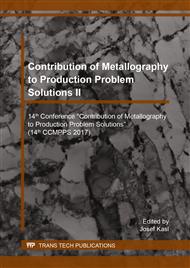[1]
K. –H. Mayer, The development of Creep-resistant Steels, in Abe, F., Kern, T-U., Viswanathan, R. (Eds. ), Creep-resistant steels; Woodhead Publishing, 2008, pp.15-17.
DOI: 10.1533/9781845694012
Google Scholar
[2]
V. Sklenička, L. Kloc, in: Power Plant Life Management and Performance Improvement, edited by E. Oakey, Woodhead Publishing Ltd., Oxford, ( 2011), p.180, (Chapter 5).
Google Scholar
[3]
V. Sklenicka, V. Kucharova, M. Svobodova, M. Kvapilova, P. Kral, L. Horvath, Creep properties in similar weld joint of a thick-walled P92 steel pipe, Mater. Character. 119 (2016) 1-12.
DOI: 10.1016/j.matchar.2018.01.008
Google Scholar
[4]
D.J. Abson, J.S. Rothwell, Review of type IV cracking of weldments in 9-12 %Cr creep strength enhanced ferritic steels, International Materials Reviews 58 (2013) 437-473.
DOI: 10.1179/1743280412y.0000000016
Google Scholar
[5]
H. Cerjak, P. Mayr, Creep strength of welded joints of ferritic steel, in Abe,F., Kern, T-U., Viswanathan, R. (Eds. ), Creep-resistant steels; Woodhead Publishing , 2008, pp.472-503.
DOI: 10.1533/9781845694012.2.472
Google Scholar
[6]
S.V. Raj, G.M. Pharr, A compilation and analysis of data for the stress dependence of the subgrain, Mater. Sci. Eng. 81 (1986) 217–237.
DOI: 10.1016/0025-5416(86)90265-x
Google Scholar
[7]
E. Nes, Modeling of work hardenning and stress saturation in FCC metals, Prog. Mater. Sci. 41 (1998) 129–193.
Google Scholar
[8]
H.J. Frost, M.F. Ashby, Deformation-Mechanism Maps, Pergamon Press, Oxford, (1982).
Google Scholar
[9]
W. Blum, Y.J. Li, Y. Zhang, J.T. Wang, Deformation resistance in the transition from coarse-grained to ultrafine-grained Cu by severe plastic deformation up to 24 passes of ECAP, Mater. Sci. Eng. A 528 (2011) 8621.
DOI: 10.1016/j.msea.2011.08.010
Google Scholar
[10]
P. Kral, J. Dvorak, W. Blum, E. Kudryavtsev, S. Zherebtsov, G. Salishchev, M. Kvapilova, V. Sklenicka, Creep study of mechanisms involved in low-temperature superplasticity of UFG Ti-6Al-4V processed by SPD, Mater. Character. 116 (2016) 84-90.
DOI: 10.1016/j.matchar.2016.04.007
Google Scholar
[11]
T. Watanabe, H. Fujii, H. Oikawa, K.I. Arai, Grain boundaries in rapidly solidified and annealed Fe-6. 5 mass % Si polycrystalline ribbons with high ductility, Acta Metall 37 (1989) 941-952.
DOI: 10.1016/0001-6160(89)90021-7
Google Scholar
[12]
T. Watanabe, Grain boundary engineering: historical perspective and future prospects, J. Mater. Sci. 46 (2011) 4095–4115.
DOI: 10.1007/s10853-011-5393-z
Google Scholar
[13]
T. Watanabe, S. Tsurekawa, the control of brittleness and development of desirable mechanical properties in polycrystalline systems by grain boundary engineering, Acta Mater. 47, (1999) 4171-4185.
DOI: 10.1016/s1359-6454(99)00275-x
Google Scholar
[14]
Z. Nishiyama, Mechanism of transformation from face-centred to body-centred cubic lattice. Sci Rep Tohoku Imp Univ 23 (1934) 637-658.
Google Scholar


